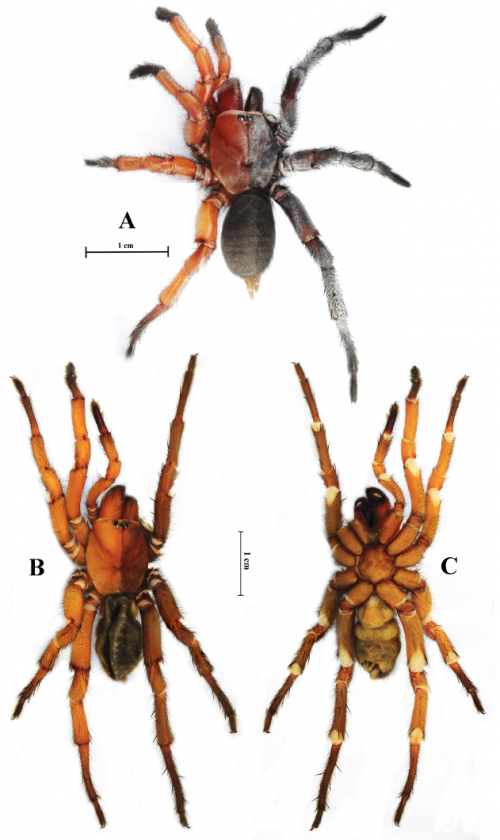Arachnologists poking around in Thailand discovered a new species of mygalomorph, Damarchus inazuma. One individual was particularly unusual: it’s a gynandromorph!

Damarchus inazuma sp. nov. gynandromorph (ARA–2021–273). A dorsal habitus (live); B dorsal habitus (preserved); C ventral habitus (preserved). Scale bars: 1 cm (A, B, C).
Female side is on the left, male on the right.
Kunsete, C., Thanoosing, C., Sivayyapram, V., Traiyasut, P. & Warrit, N. (2025) New insights into Damarchus: a new species and gynandromorph description from Thailand (Araneae: Bemmeridae). Zootaxa, 5696 (3), 409–424. https://doi.org/10.11646/zootaxa.5696.3.6


PZ, how can that be? The good christian terrorists teach us there are only male and female and nothing else! (ROFLMAO)
Seriously, that is fascinating. I noted that the number of legs is uneven on each side. Is that part of a mutation?
Does the gyandromorph really have five legs or stumps a side? Or is the fifth ‘leg’ something else?
…Oh, they killed it. That’s very sad.
@ previous commenters: it’s very common for tarantulas to lose legs under stress, so it was probably an injury. might have even happened during capture.
off topic, but important: I hope PZ is making progress in the effort to regain health in all aspects. I (and I’m sure others) would like to hear from you, PZ, in regard to that.
@3 Nice Ogress wrote: it’s very common for tarantulas to lose legs under stress,
I reply: That makes sense. However, the 5 leg ‘roots’ on each side still seem to be some sort of mutation. (he said, being ‘sciencey’)
@5 shermanj
as a physicist, i can confidently tell you: i agree with your count of 10 total leg “root” thingies.
also, look at the left side of the spider. everything is slightly larger! i suppose i could google, but i bet female tarantulas are larger. pretty neat that the gynandromorpism conserves the relative sex sizes!
must be awkward for the spiders arachnid locomotion!
does it only walk in circles?
… it’s a gynandromorph!
Surely the woke and politically/grammatically correct formulation would be they’re a gynandromorph!
That orange and black coloration does fit the season…
@5 shermanj
It has the normal amount of “leg roots” (coxae). You are probably counting the pedipalps as legs for some reason.
Hmm… If it was standard for every individual in a species to have a dual set of sexual organs, it would be easier to find a mate. But as evolution tries to reduce the amount of energy spent on growing organs, this is not happening. I think some earthworms may be an exception.
There aren’t 10 leg “roots”. There are 8 legs, and a pair of pedipalps.
As lasius said before me!
Professor Dawkins was unavailable for comment.
(/snark)
J. K. Rowling in her grave confusion.
Well he/she/they could definitely bite those gender denying, god-bothering, Republican clowns in the bum.
I wish they’d looked into the genetic/developmental mechanism behind this. Would have been interesting. Probably didn’t have the budget.
I do like the terminology.
[androgynomorph ↔ gynandromorph]
(or, android vs gynoid)
@ ^
Quite. The female taking precedence. Whatever will they think of next?
I notice it’s the male half that has bits missing. Puny Male!!
Thanks, @8 lasius and @10 PZ Myers for the clarification. All 10 looked the same to me. But, then I’m not an expert on spiders.
I know I’ve seen pictures of budgies like this as well: some of them are split right down the middle, and while the ‘male on one side, female on the other’ isn’t obvious at first glance, the fact that they were blue and white on one side, but green and yellow on the other, was obvious at first glance. It’s an uncommon but far from unheard of condition in birds.
I don’t know about the spider here, but in the case of the birds where this has happened it has usually been a case of two originally-separate fertilized eggs attaching together inside the womb basically when the number of cells in the embryo is still in the single digits. So it’s a genetic chimera: the two halves are essentially fraternal twins. This spider may be the same; frankly the purely down-the-middle divide suggests that possibility rather than a breakdown any later in the process.
(With the birds, I believe the usual answer to ‘but what sex is it’ is that the left ovary is dominant, so if the left side is female than the bird is still capable of laying eggs, but if the left side is male then it isn’t.)
I first read the word ‘gynandromorph’ in the Patrick O’Brian novels about five years ago. I have never done so much googling or dictionary diving since grade shool while reading those novels. I remember that the ship’s Doctor Maturin reffered to the “Clouded Yellow butterfly” as a “bilateral gynandromoph”.
@David Utidjian:
Yeah, I can see how it would show up in one of those books. (Only actually seen the movie myself, but had a friend who was a big fan of the books, and who was the reason I saw the movie.)
‘Bilateral gynandromorph’ is basically what this spider above (or the budgie I mentioned) is: split right down the middle with each side a different sex (and generally different genetics entirely, being effectively conjoined fraternal twins). It’s rare, but at the same time this specific form is one of the more common versions of chimerism. Or, at least, one of the more common versions that’s actually likely to survive until birth.